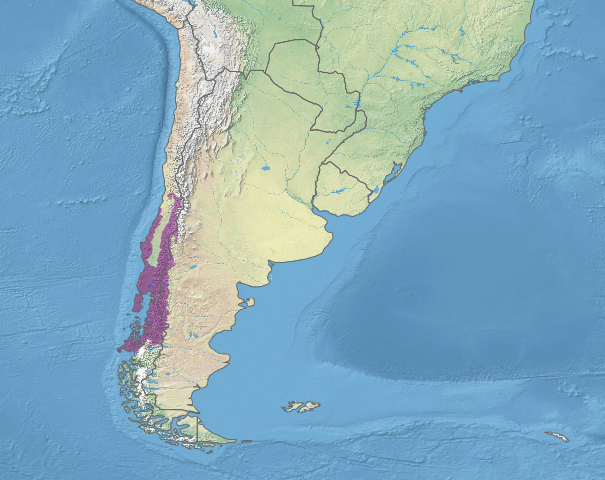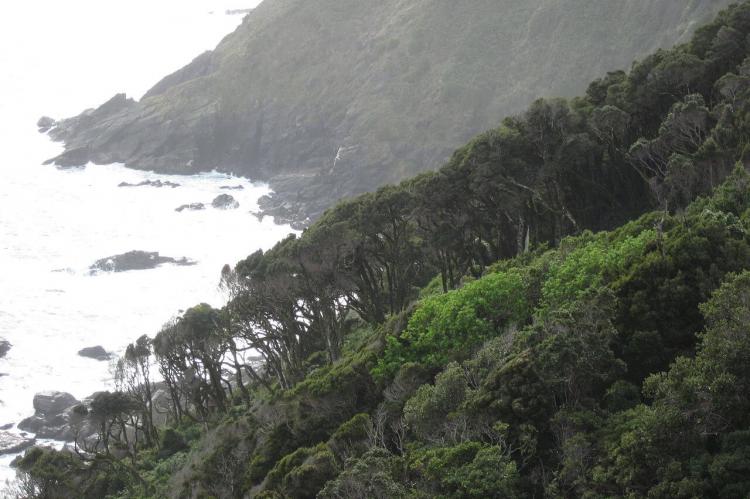Valdivian Temperate Forests Ecoregion (South America)
The Valdivian temperate forests ecoregion is located in the Southern cone of South America. It covers a narrow strip between the western slope of the Andes and the Pacific Ocean. The forests are characterized by their dense understories of bamboo, ferns, and evergreen trees.
Valdivian Temperate Forests
The Valdivian temperate forests ecoregion is located in the Southern Cone of South America on Chile's west coast and extends slightly into Argentina. It covers a narrow continental strip between the western slope of the Andes and the Pacific Ocean. It is part of the Neotropical ecozone.
The Valdivian temperate forests (Selva Valdiviana) are temperate broadleaf and mixed forests. The woods are characterized by their dense understories of bamboo, ferns, and evergreen angiosperm trees, along with some deciduous and conifer trees.
Part of the Andean Patagonian Forest (Bosque Andino Patagónico), these temperate rain forests comprise a relatively narrow coastal strip between the Pacific Ocean to the west and the southern Andes Mountains to the east, from roughly 37° to 48° south latitude.
Much of the Valdivian temperate forests ecoregion was covered by the Patagonian Ice Sheet and other glaciers at the peak of the last ice age, which descended from the Andes mountains.
The numerous lakes of the Chilean lakes district in the central part of the ecoregion were originally glacial valleys. In contrast, the southern part of the region has many glacier-carved fjords.
To the north, the Valdivian forests give way to the Mediterranean forests, woodlands and scrub of the Chilean Matorral ecoregion. To the south lies the Magellanic subpolar forests ecoregion.
Since the forest is located at around 40 degrees south latitude, it is strongly influenced by the westerlies. The water vapor held by the westerlies condenses as they arrive at the higher part of the windward slope of the Andes, thus creating rainfall.
At the same time, the northward-flowing oceanic Humboldt Current creates humid and foggy conditions near the coast. In the summer, the temperature can climb to 16.5 °C (62 °F), while during winter, the temperature can drop below 7 °C (45 °F).
The temperate Valdivian, Matorral, and Magellanic ecoregions are isolated from the subtropical and tropical forests of northern South America by the Atacama Desert north of the Matorral, the Andes Mountains, and dry rain-shadow Argentine grasslands east of the Andes.
As a result, the temperate forest regions have evolved in relative isolation, with a high degree of endemic species.
Flora and Fauna
The entire ecoregion contains 700 - 800 species of vascular plants. Endemism at the species level is estimated to be 45% for all vertebrates, 76% for amphibians, 50% for freshwater fish, 36% for reptiles, 33% for mammals, and 30% for birds.
Amphibians of interest include three endangered species and the critically endangered Vanzolini's spiny-chest frog.
Unique mammal species include the monito del monte (Dromiciops gliroides), an arboreal marsupial, the southern pudú (Pudu pudu), the world's smallest deer, and the kodkod.
Endemic birds of the forest understory, particularly in the family Rhynocriptidae, are the most ecologically studied species concerning population longevity.
The alerce tree is declared a National Monument of Chile. A range of restoration efforts has been initiated to assist the recovery of this once dominant species to landscapes where it was eliminated.
Protection Status
The main threats to the Valdivian Temperate Forests include logging for commercial purposes and firewood.
National Parks protect approximately 25% of the Valdivian temperate forests ecoregion.
Protected areas within Argentina include:
Protected areas within Chile include:

Map depicting the location of the Valdivian temperate forests (in purple)
